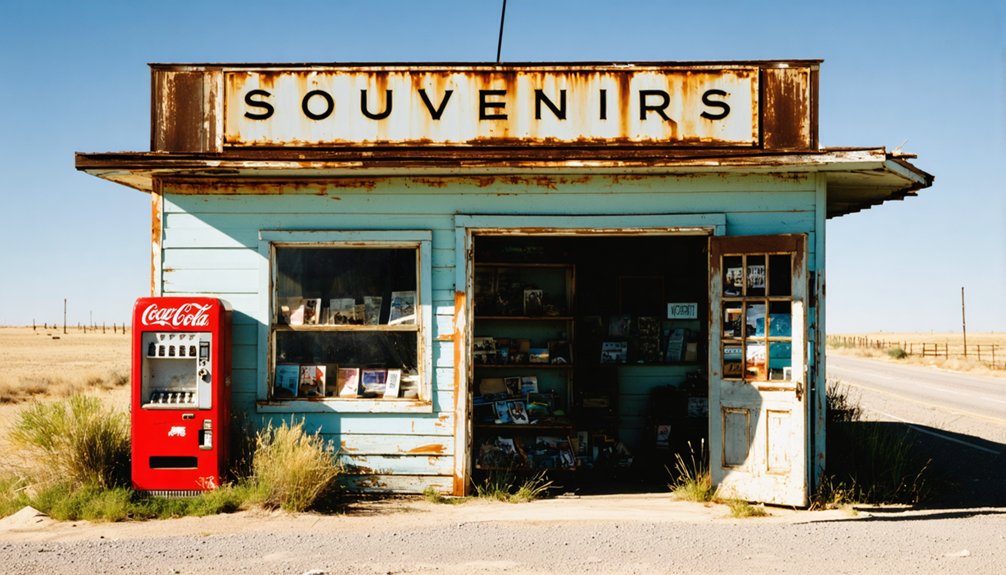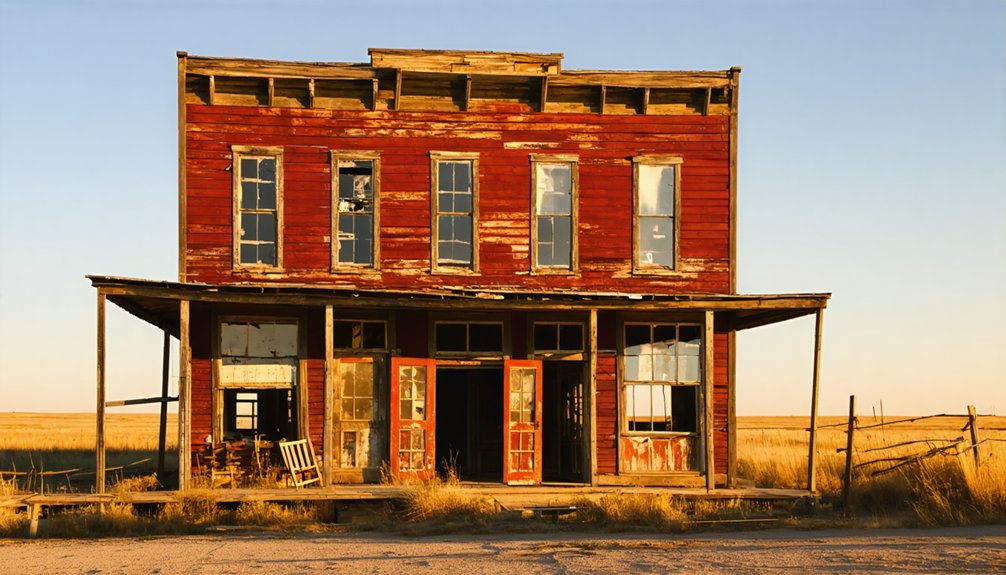You’ll find Okaton, South Dakota along Interstate 90, where a weathered grain elevator and decaying railroad buildings tell the story of a once-thriving railroad town. Founded in 1906 during the Chicago, Milwaukee & St. Paul Railroad expansion, Okaton flourished briefly before declining as rail workers moved on and farming families struggled. By the 1980s, a failed tourist revival attempt couldn’t save the town. Today, with just 23-31 residents nearby, Okaton’s haunting ruins hold secrets of America’s rural past.
Key Takeaways
- Okaton began as a railroad town in 1906 but declined after Interstate 90 bypassed it and railroad service ended in the 1980s.
- By 2023, only 23-31 residents remain, mostly living on nearby farms rather than in the town’s deteriorating center.
- Historic structures include a weathered wooden grain elevator, deteriorating scalehouse, and various abandoned railroad-era buildings marked as private property.
- A brief tourist revival in the mid-1980s marketed “Westlake’s Ghost Town!” with attractions, but interest faded after the owners’ deaths.
- The ghost town attracts photographers and curious travelers from I-90, though many structures are unsafe and restricted as private property.
The Rise and Fall of a Railroad Town
When the Chicago, Milwaukee & St. Paul Railroad pushed westward in 1906, you’d have witnessed the birth of Okaton, South Dakota. The railroad expansion brought an immediate influx of workers who needed housing, sparking the town’s initial growth.
While larger rail hubs flourished with extensive infrastructure, Okaton remained modest in size. The nearby town of Murdo featured a bustling roundhouse and passenger station. The economic impact was significant but brief. Today, the town’s crumbling buildings stand as silent reminders of its past. Early businesses sprang up to serve railway crews and homesteaders, while surrounding farmland supported grain and cattle operations.
However, the prosperity wouldn’t last. Rail workers moved on as construction progressed, leaving farming families to face harsh Great Plains conditions. By the time the Great Depression hit, many residents had already begun departing for urban opportunities.
The final blow came when Interstate 90 bypassed the town and railroad service ended in the 1980s.
Historical Landmarks and Abandoned Structures
Standing as a tribute to Okaton’s railroad past, you’ll find the weathered wooden grain elevator dominating the landscape with its distinctive silhouette, now missing its top section from years of wind damage.
The elevator’s strategic position alongside the overgrown railroad tracks showcases its former role in the town’s agricultural operations, when trains regularly stopped to load grain bound for distant markets. The structure once served as a movie setting but is now considered unsafe for visitors to approach.
You can still spot remnants of the railroad infrastructure that once served as Okaton’s lifeblood, though most areas are now fenced off with “Keep Out” signs to protect both the historic structures and visitors. After its founding in 1906 for railroad workers, Okaton experienced a steady decline in population due to the eventual closure of the railroad and harsh winter conditions.
Railroad Heritage Buildings
Several railroad heritage buildings in Okaton serve as reminders of the town’s railroad origins from 1906, when the Chicago, Milwaukee & St. Paul Railroad established operations.
The town’s railroad architecture faces significant preservation challenges today, with most structures in various stages of decay. The scalehouse office has deteriorated significantly since 2006, with its roof now completely collapsed.
You’ll find these key remnants of Okaton’s railroad past:
- A wooden grain elevator standing alongside overgrown tracks, though it’s lost its top section
- Various small buildings from the railroad era, now deteriorating and marked with private property warnings
- The original railroad corridor, still visible through town despite abandoned, overgrown tracks
While tourism efforts in the 1980s tried to showcase these historic structures through a “ghost town” attraction, most railroad heritage buildings remain neglected, slowly succumbing to time and harsh Dakota weather.
The famous Bingo Grain Co name can still be seen faded on the grain elevator’s weathered exterior.
Old Grain Elevator Story
Among Okaton’s most striking railroad relics, the historic grain elevator tells a compelling story of the town’s rise and decline.
You’ll find this prairie skyscraper standing as a symbol of the once-thriving grain industry that flourished alongside the Chicago, Milwaukee, and St. Paul railroad line.
Originally operating as Okaton Grain Co., the structure briefly transformed into “Bingo Grain Co.” during a movie production, adding an unexpected chapter to its history.
Today, the elevator’s visual appeal draws photographers from across the country, even as South Dakota’s harsh winds continue to chip away at its weathered frame.
While you can’t enter the structure due to private property restrictions, you’ll witness the dramatic effects of time and elements on this remarkable piece of railroad heritage that’s gradually surrendering to nature’s persistent force.
After the railroad ceased operations in the 1980s, the grain elevator fell into disuse and began its slow descent into decay.
Photos dating back to 2006 and 2013 reveal the building’s steady deterioration over the years.
Life Along the Railroad Tracks
If you’d lived in early Okaton, you’d have witnessed railroad workers rising before dawn to maintain the Milwaukee Railroad‘s tracks that stretched across the prairie.
You’d have seen crews performing essential tasks like inspecting rails, replacing worn ties, and clearing snow during harsh South Dakota winters.
Like many South Dakota settlements, town survival depended on maintaining reliable rail service through the region. The rhythmic sounds of passing trains and the daily routines of railroad maintenance became the heartbeat of this small prairie town, where workers’ lives revolved around the railroad’s demanding schedule. The town’s eventual decline was hastened when the railroad closed down and Interstate 90 bypassed the community.
Railroad Workers’ Daily Routine
Working as a railroad brakeman in Okaton meant facing constant physical dangers while performing critical duties throughout each shift. You’d battle the elements year-round, risking frostbite in winter while running alongside tracks on hazardous, uneven surfaces.
Your brakemen duties required incredible coordination and stamina:
- Manually applying brakes on each car, moving between cars on moving trains.
- Throwing switches along the rail line, often sprinting ahead or behind the train.
- Using communication signals – flags by day, red lanterns by night – to alert engineers and conductors.
You’d live in company housing near the rail yards, separated from family with an unpredictable schedule. The work was isolating, with social connections limited to fellow railroad workers during your irregular shifts.
Tracks Through Prairie Life
When the Milwaukee Railroad pushed westward through South Dakota in 1906, it planted the seeds for Okaton’s birth along its expanding track system. You’d have found a bustling mix of railroad workers and homesteaders transforming the untamed prairie into a new community.
The railroad expansion brought opportunity, with businesses sprouting near the tracks to serve both the transient rail workers and permanent farming families.
Life wasn’t easy in this prairie settlement. You’d have faced harsh winters and isolation, but the railroad provided your lifeline to the outside world.
While railroad workers came and went with the ebb and flow of rail operations, determined farmers stuck it out, working the surrounding land despite environmental challenges.
The tracks didn’t just carry trains – they carried the hopes and perseverance of Okaton’s pioneers.
From Bustling Hub to Silent Streets
Though Okaton began as a promising railroad town in 1906, its transformation into a ghost town unfolded through several distinct phases of decline.
The town’s initial growth relied on its transient population of railroad workers, who quickly moved on as construction progressed westward. Despite the agricultural resilience of local farmers and ranchers, harsh winters and economic pressures took their toll.
The town’s decline accelerated through:
- The Great Depression forcing many residents to seek urban employment
- Decreasing viability of small farms pushing families away from the region
- The railroad’s closure in the mid-1980s, followed by I-90 bypassing the town
A Failed Tourist Revival

Despite decades of decline, Okaton experienced a brief resurgence in the mid-1980s when Robert and Evelyn Westlake purchased property to transform the ghost town into a tourist destination.
You’d have found their “Westlake’s Ghost Town!” advertised along Interstate 90, complete with a rock shop, gas pumps, and a general store serving refreshments. They even built a ghost town facade and added a petting zoo to draw visitors.
The tourist attraction decline began after the Westlakes’ deaths. Their properties were sold, the facade removed, and the signs taken down.
Economic challenges, including the town’s remote location, harsh winters, and lack of infrastructure, proved insurmountable. The closure of the post office in 2013 marked the end of formal services, leaving Okaton to return to its ghostly silence.
Modern-Day Ghost Town Legacy
Although Okaton’s population has dwindled to between 23 and 31 residents as of 2023, the town’s physical remnants tell a compelling story of rural decline.
You’ll find most residents living on nearby farms rather than in the deteriorating town center, where the ghost town allure draws curious travelers from I-90.
The town’s preservation challenges are evident in three key ways:
- Derelict structures, including a wooden grain elevator missing its top and abandoned houses, continue to decay.
- Private property restrictions limit access, with “Keep Out” signs protecting unsafe buildings.
- Former tourist attractions, like the petting zoo and rock shop, have completely shut down.
Today, you can experience Okaton’s history primarily through photography from public roads, as this once-thriving railroad town stands as a monument to Great Plains depopulation.
Frequently Asked Questions
Are There Any Paranormal or Haunted Locations Reported in Okaton?
You won’t find documented ghost sightings or haunted history in this town. While its abandoned buildings and empty streets feel eerie, there’s no credible evidence of paranormal activity here.
What Happened to the Original Residents’ Descendants After Leaving Okaton?
You’ll find descendant stories revealing that families migrated to urban centers during the Depression, pursuing industrial and service jobs. Many established new family connections across the Midwest while maintaining their heritage ties.
Can Visitors Legally Explore and Photograph the Abandoned Buildings?
While you might be enthusiastic to explore, you can’t legally enter or photograph inside the buildings. You’re only permitted to view and take pictures from public roads and sidewalks.
What Was the Name of the Unreleased Movie Filmed in Okaton?
You won’t find the film’s name in any Okaton history records. While it’s confirmed an unreleased film was shot there, with the grain elevator repainted for filming, the title remains a mystery.
Does Okaton Still Hold Any Community Events or Gatherings?
You won’t find any community gatherings or local traditions in Okaton today. Due to private property restrictions, posted “Keep Out” signs, and a virtually nonexistent population, public events aren’t held there anymore.
References
- https://www.legendsofamerica.com/sd-okaton/
- https://www.powderhouselodge.com/black-hills-attractions/fun-attractions/ghost-towns-of-western-south-dakota/
- https://www.blackhillshikingbikingandmore.com/okaton
- https://photobyjohnbo.com/2021/01/26/okaton-south-dakota/
- https://icatchshadows.com/okaton-and-cottonwood-a-photographic-visit-to-two-south-dakota-ghost-towns/
- https://www.youtube.com/watch?v=ifDOcffR6mw
- https://www.atlasobscura.com/places/okaton-ghost-town
- https://www.abandonedspaces.com/towns/okaton-south-dakota.html
- https://www.cristenjoyphotography.com/okaton-elevator-changes-of-the-past-12-years/
- https://www.youtube.com/watch?v=jmSADvq4Lek



